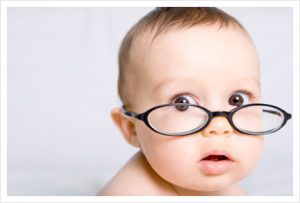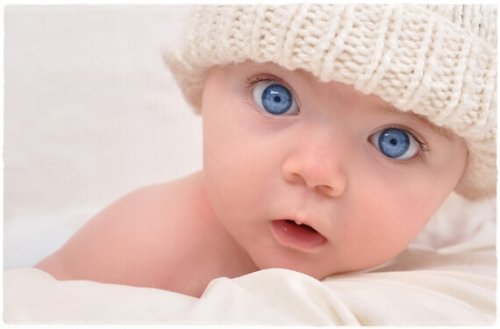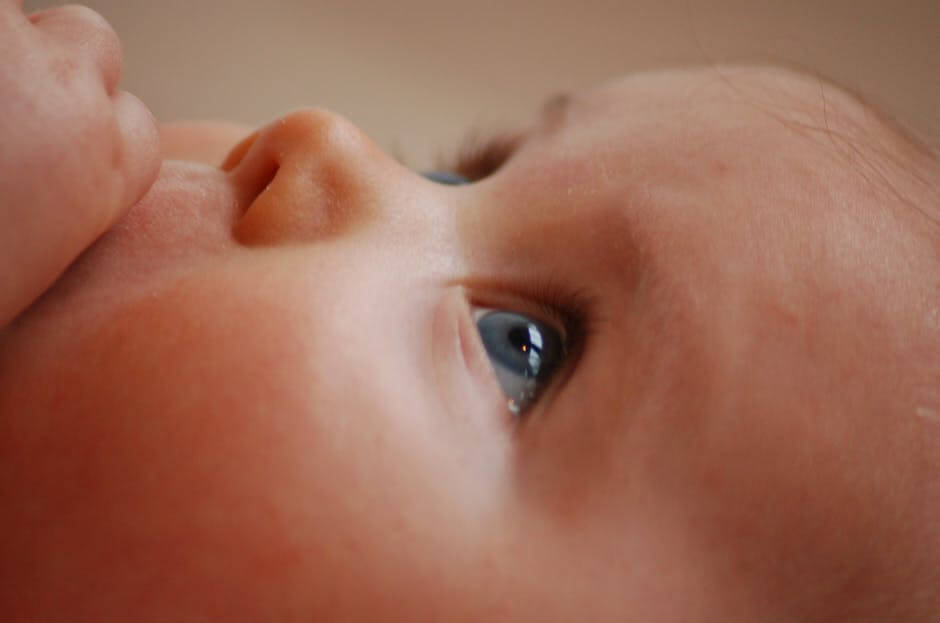When Do Babies Start to See?

Our sense of sight plays an important role in the way human beings perceive the outside world. Our vision begins to develop from the moment we’re born and goes through different stages. Next, we’ll explain in detail the way babies start to see.
When they are born, a characteristic feature of babies is to keep their eyes wide open almost all the time. It’s common to fall into the mistaken belief that newborns try to examine the new world around them. However, in reality they see practically nothing.
As much as their eyes remain open, in those first minutes of life, babies still cannot see. Like the other senses, their vision will progress gradually and the child will have to get used to it little by little.
Vision in the First Month of Life
Newborn babies are able to notice contrasts and changes in lighting. For example, they can perceive flashing lights or notice when, from the darkness, we turn on a light in a room. At that moment the closing reflex action of their pupils is activated to not blind them.
As the days go by, they will begin to distinguish figures, although somewhat vague. Their mothers’ face, on the other hand, will be one of the first things they will detect. Beyond what they see with their eyes, they will be able to sense the mother with touch, smell, and her warmth and voice.
When babies are about two weeks old, they can see objects approximately 25 centimeters away with some clarity. For that reason, they will be able to observe their mother during breastfeeding.
However, it won’t be until one or two months that they will be able to focus well. Similarly, they won’t be able to see at a distance greater than 30 centimeters without being cross-eyed.

So, At What Point Do Babies Start to See?
From approximately the second month of life, babies already have some control of their sight, which allows them to fix their gaze on a point and see it better. At this stage, they will notice a special interest in bright colors and things that shine.
Before, they weren’t able to differentiate similar colors, but rather they noticed the contrasts between, for example, black and white. As the weeks of the third month pass, their range of colors expands.
As of this third month, babies are sufficiently precise with their sight to notice more details, like buttons on a garment or some particular feature of their toys.
Later, when they’re four months old, babies will enter the final stretch. At this time, they gradually acquire the following abilities:
- Following faces and objects with their eyes.
- Distinguishing colors with greater precision.
- Seeing more in general.
- Looking for things with their eyes.
At about seven months old, babies finally reach full development of their sense of sight. Of course, there isn’t a set time for each child: each will have his or her own pace of development.
Sight Doesn’t Just Depend on the Eyes
Like so many other human processes, sight depends on the “central command” that manages everything we do: the brain.
Therefore, even if babies’ eyes are formed from the 26th week of pregnancy, their brain isn’t developed enough yet to process this information.
You must understand babies’ growth as a whole, not just separate parts. As their eyes become fully developed, their nervous system will learn to establish the necessary connections to interpret signals.
These improvements can mainly be noticed in the coordination of their eye movements. Subsequently, they will also make the images much sharper, as well as their ability to interpret them.
On the other hand, the movements of their back and neck muscles become stronger, allowing them to direct their gaze to different places.
So it’s normal that they begin to focus on their environment, as they’re now able to explore it whenever they want. This usually occurs when they’re 10 weeks old.

Tips to Take Care of Babies’ Sight
- Don’t expose them to sunlight for long periods.
- Perform the eye checkups suggested by the pediatrician.
- After breastfeeding for first six months, make sure to incorporate healthy and nutritious foods.
- Cut their nails and make sure they don’t hurt themselves with their hands or put objects in their eyes.
“As their eyes become fully developed, their nervous system will learn to establish the necessary connections to interpret signals.”
With these basic care tips, you’ll promote health that will allow your child to avoid problems in the future. From the moment babies start to see, we must treat their sight as what it is: one of the most important senses of a human being.
Our sense of sight plays an important role in the way human beings perceive the outside world. Our vision begins to develop from the moment we’re born and goes through different stages. Next, we’ll explain in detail the way babies start to see.
When they are born, a characteristic feature of babies is to keep their eyes wide open almost all the time. It’s common to fall into the mistaken belief that newborns try to examine the new world around them. However, in reality they see practically nothing.
As much as their eyes remain open, in those first minutes of life, babies still cannot see. Like the other senses, their vision will progress gradually and the child will have to get used to it little by little.
Vision in the First Month of Life
Newborn babies are able to notice contrasts and changes in lighting. For example, they can perceive flashing lights or notice when, from the darkness, we turn on a light in a room. At that moment the closing reflex action of their pupils is activated to not blind them.
As the days go by, they will begin to distinguish figures, although somewhat vague. Their mothers’ face, on the other hand, will be one of the first things they will detect. Beyond what they see with their eyes, they will be able to sense the mother with touch, smell, and her warmth and voice.
When babies are about two weeks old, they can see objects approximately 25 centimeters away with some clarity. For that reason, they will be able to observe their mother during breastfeeding.
However, it won’t be until one or two months that they will be able to focus well. Similarly, they won’t be able to see at a distance greater than 30 centimeters without being cross-eyed.

So, At What Point Do Babies Start to See?
From approximately the second month of life, babies already have some control of their sight, which allows them to fix their gaze on a point and see it better. At this stage, they will notice a special interest in bright colors and things that shine.
Before, they weren’t able to differentiate similar colors, but rather they noticed the contrasts between, for example, black and white. As the weeks of the third month pass, their range of colors expands.
As of this third month, babies are sufficiently precise with their sight to notice more details, like buttons on a garment or some particular feature of their toys.
Later, when they’re four months old, babies will enter the final stretch. At this time, they gradually acquire the following abilities:
- Following faces and objects with their eyes.
- Distinguishing colors with greater precision.
- Seeing more in general.
- Looking for things with their eyes.
At about seven months old, babies finally reach full development of their sense of sight. Of course, there isn’t a set time for each child: each will have his or her own pace of development.
Sight Doesn’t Just Depend on the Eyes
Like so many other human processes, sight depends on the “central command” that manages everything we do: the brain.
Therefore, even if babies’ eyes are formed from the 26th week of pregnancy, their brain isn’t developed enough yet to process this information.
You must understand babies’ growth as a whole, not just separate parts. As their eyes become fully developed, their nervous system will learn to establish the necessary connections to interpret signals.
These improvements can mainly be noticed in the coordination of their eye movements. Subsequently, they will also make the images much sharper, as well as their ability to interpret them.
On the other hand, the movements of their back and neck muscles become stronger, allowing them to direct their gaze to different places.
So it’s normal that they begin to focus on their environment, as they’re now able to explore it whenever they want. This usually occurs when they’re 10 weeks old.

Tips to Take Care of Babies’ Sight
- Don’t expose them to sunlight for long periods.
- Perform the eye checkups suggested by the pediatrician.
- After breastfeeding for first six months, make sure to incorporate healthy and nutritious foods.
- Cut their nails and make sure they don’t hurt themselves with their hands or put objects in their eyes.
“As their eyes become fully developed, their nervous system will learn to establish the necessary connections to interpret signals.”
With these basic care tips, you’ll promote health that will allow your child to avoid problems in the future. From the moment babies start to see, we must treat their sight as what it is: one of the most important senses of a human being.
This text is provided for informational purposes only and does not replace consultation with a professional. If in doubt, consult your specialist.








